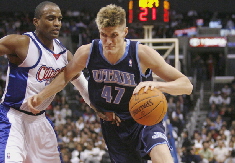
|

Athlete’s Health Risks
When you drive your body to its limits... extra maintenance is required!!!
 When we speak of groups that are at risk, we don’t always think of athletes... but we should — being an athlete involves a nutritional risk that many do not think about. When we speak of groups that are at risk, we don’t always think of athletes... but we should — being an athlete involves a nutritional risk that many do not think about.
The scientific explanation for this risk is perhaps best understood by thinking of a racing car compared to an ordinary commuter car (or an athlete compared to a sedentary person).
- A racing car deals with more stress and strain in one race than a commuter car does in many years of driving a few miles each day back and forth.
- A racing car uses up far more rubber, more gasoline, more oil and creates more heat and wear and tear on the engine than does considerable commuting in the the family car.
Similarly:
- Athletes use up many times more minerals than do people who are sedentary.
- An athlete sweats more in 5 years of athletic training and competition than couch potatoes do in 75 years of watching TV.
- When a person sweats they are not just losing water... their sweat contains 60 essential minerals.
- They are called essential minerals because if any of them are missing for any length of time, the result can be a degenerative disease, many of which are life threatening.
- So, if athletes don’t get additional minerals and trace elements in their diets to make up for those which have been lost, their very lives can be at risk.
- This is evidenced as numerous athletes each year, at very young ages, die of unexpected heart attacks. Wellness experts attribute this to loss of minerals needed for arterial integrity.
- Additionally, athletes use more energy and consume and metabolize more food. This means more free radicals are created. Free radicals cause damage to the body.
- Finally, athletes tear down their muscles and bones and tendons through the exertions they make. They need food nutrients to repair this damage.
 |
The single most important nutrient supplement for athletes is Kona Minerals. It contains a bioavailable source of all the minerals and trace elements from a source 1/2 mile under the sea of the Kona Hawaii coast. These minerals are uncontaminated by pollution and are in the bloodstream in less than two hours. Athletes need to eat many times more minerals daily to compensate for the minerals lost in workouts and competition. Supplementing the diet with six capsules per day of Kona Minerals might be the wisest thing an athlete could do.
Note that the controversial writer of ‘Dead Doctors Don’t Lie’, veterinarian, Dr. Joel Wallach, blames sudden death in athletes on the lack of minerals, caused by sweating too many of the minerals from the body. He points to the addition of a tiny amount of minerals in the feed of animals as being the single most important thing anyone taking care of animals can do for animal health and draws the same corollary to humans.
The next thing that athletes need to do is increase their antioxidant intake. Antioxidants combat free radicals which attack arterial walls and create scarring and thickened walls. Performance stress and metabolism of extra fuel as compared to sedentary people mean far greater free radical loads in athletes.
Here are are recommended sources of increased amounts of antioxidants:
- Seven Essentials - 21,000 ORAC units per serving (the highest amount of per-serving antioxidants available at any price).
- Earthing - get infinite numbers of free electrons (each free electron is an antioxidant) while you are sleeping.
- Glutathione precursors - glutathione is the master mitochondrial antioxidant. The mitochondria is where energy is made from food fuel.
Finally, increased nitric oxide levels afford a greater degree of arterial protection. Nitric oxide is obtained from arginine supplementation. Best natural sources of arginine include snails, walnuts, pine seeds and sesame seeds. These have to be eaten away from other food, however go here for more information on Arginine supplementation.
|

|

Sudden Death of Athletes Occurs Too Often
Usually, the report we get on the news says that the athlete suffered from a cardiovascular abnormality.
Sudden death has been defined as "an abrupt unexpected death of cardiovascular cause, in which the loss of consciousness occurs within 1 to 12 hours of onset of symptoms" (1, 2). The majority of sudden deaths in athletes occur during or immediately after exercise (game, conditioning, training, etc). However, some deaths occur at rest or during sleep. Autopsy is very useful in making a definitive diagnostic determination of the cause of sudden death. Certain conditions (i.e., Long QT Syndrome, Brugada Syndrome) require detailed post-mortem biochemical and sometimes genetic studies.
Scientists in discussing how to prevent such sudden deaths among athletes say things like this:
Intense training and the strain of competition, which increase physiologic demands on the heart, produce alterations in electrolytes, blood volume and levels of hydration and together increase sympathetic tone and withdrawal of parasympathetic tone. Multiple interactions of those factors with the hypertrophied myocardium and the disarray of myocardial fibers act as triggers for potentially lethal ventricular arrhythmia’s (24). Also, increased myocardial mass and insufficient regional perfusion during high-intensity exercise cause myocardial ischemia, and over time, replacement fibrosis, both of which may act as independent triggers of arrhythmia’s. In fact, patients with HCM that survived a sudden death had a very high incidence of inducible ischemia on thallium stress-testing (25). In addition, lack of appropriate blood pressure and heart rate response to exercise may act as the initial event cascading into a hemodynamic collapse with loss of consciousness. Finally, partial obstruction present at rest may increase twice as high with intense physical exercise compared to levels at baseline (26), which can potentially result in myocardial ischemia, hemodynamic compromise and arrhythmia’s. Autopsy, Histological and microscopic studies, and sometimes biochemical tests establish a post-mortem diagnosis of HCM.
The bottom line is that athletes need to increase their nutrition levels considerably above ordinary people.
|

 When we speak of groups that are at risk, we don’t always think of athletes... but we should — being an athlete involves
When we speak of groups that are at risk, we don’t always think of athletes... but we should — being an athlete involves 